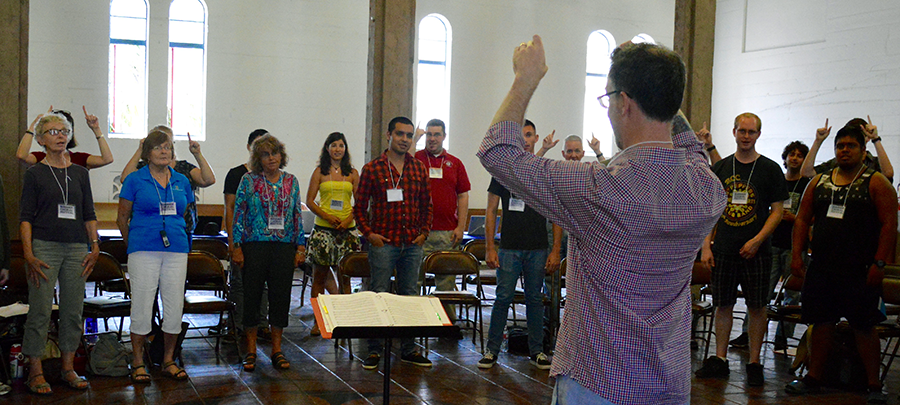For ages, people have loved listening to and performing choral music, which has developed and changed along with the history of music. The advances in compositional techniques, stylistic choices, and cultural background that have resulted in the striking differences between modern choir music and early choir music are readily apparent. In this piece, we’ll go on a trip of comparison, looking at the similarities and differences between modern and ancient choir music in terms of their qualities, influences, and contributions. By comparing and contrasting these two styles, we can better understand the development of this ageless musical practice
First, some background history.
Choral music has its roots in the Middle Ages and the Renaissance, when it was first used in religious contexts. Polyphony and complex vocal harmonies were its hallmarks, and it was written particularly for use in religious services. Josquin des Prez, Thomas Tallis, and Giovanni Pierluigi da Palestrina are just a few of the early composers who made significant contributions to choral music.
In contrast, the styles and genres that make up modern choral music are more open-ended. It first appeared in the twentieth century and is still developing now. Eric Whitacre, Morten Lauridsen, and Ola Gjeilo are just a few of the modern composers who have made significant contributions to the canon of choral music. This style broadens the definition of choral music to include elements of classical, jazz, pop, folk, and world music.
Second, musical technique
Early choir music is marked by its contrapuntal texture, with numerous separate vocal lines intertwining and generating complicated harmonies. Imitative counterpoint, in which melodic phrases are reiterated by several voices, and modal scales were used by composers, both of which were reflective of contemporary musical practices. The songs were mostly sung without instruments, drawing attention to the harmony and clarity of the singers’ voices.
In contrast, there is a great deal of variety in the genres and methods used in today’s choral music. Harmonies, tonalities, and rhythms are explored by composers who use dissonance and nonstandard chord progressions. Extended vocal techniques including vocal percussion, whispering, and vocal improvisation are frequently used in modern music. In addition, instrumental accompaniment is commonly used in modern choir music, which broadens the auditory palette and adds richness to the performance.
Text and Theme
Religious texts and themes were the primary influences on early choir music, which reflects the importance of the church during that time. Music based on biblical or liturgical texts is a common practice for composers. The beautiful vocal harmonies were emphasized as a means of conveying feelings of devotion, spiritual introspection, and reverence.
Texts and subjects in modern choral music span a wide spectrum. Composers find motivation in everything from poetry and literature to current events and their own lives. Many modern choirs sing about relationships, activism, the natural world, and contemplation. Modern choir music aims to reach more people and talk about current issues, hence its repertoire has broadened to include songs about a wider variety of topics.
Typical Venues and Equipment
Historically, choral music has been performed primarily in religious contexts, especially during liturgical occasions. The emphasis was on the simplicity and beauty of the human voice, hence most performances were performed a cappella. Performances typically took held in acoustically resonant places like cathedrals or chapels, and choirs tended to be smaller in number.
Performance styles in today’s choral music have progressed alongside technical developments. In today’s music halls, amplification and sound reinforcement devices are frequently employed to improve the sound and balance of larger choirs. Choreography, staging, and technological enhancements are only some of the ways in which modern choirs present their music to the audience. By incorporating modern tools, the choir can explore new artistic territory and find more creative ways to convey their work to an audience.
In addition, modern choir music has been significantly influenced by technological developments in the realm of recording. With the help of high-quality recordings and digital platforms, choral performances can be widely disseminated and enjoyed by listeners all over the world. Because of this, modern choral music has gotten more attention, and choirs now have a chance to become known on a global scale.
Influence on Culture and Audience Reactions
Early choir music had a profound cultural impact in its time, especially in religious contexts. It was an integral part of church services and the congregation’s musical life. Listeners found meaning in the music’s complex harmonies and spiritual themes, responding with dedication and reverence.
Modern choral music has a wider range of listeners than only those in churches. Its creative depth and originality have earned it a position in concert halls, music festivals, and the mainstream media, where it is enjoyed by a wide range of listeners. Modern choir music has been able to reach more people and have a greater cultural impact because of its blending of different musical forms and genres.
Nowadays, it’s not uncommon for a choir to work with a different musician or band to create a new sound. Choral music has seen a resurgence in popularity thanks to these partnerships and the infusion of elements from popular music, which have served to close the gap between classical and modern music.
The contrast between modern and early choral music demonstrates the dynamic range of choral music. Contemporary choir music encompasses a wide range of styles, methods, and cultural influences, in contrast to earlier choir music’s focus on sacred themes and precise vocal harmonies. It captures the variety of today’s world and uses the strength and originality of its music to speak to issues of the day. Both types of choral music have made significant contributions to art and culture. Recognizing the unique qualities of each era allows us to honor the history of choral music while welcoming the revolutionary potential of modern manifestations. The everlasting beauty of choral music has been captivating and inspiring listeners for centuries, whether they are listening to the unadulterated polyphony of the early centuries or the experimental compositions of the present day.


